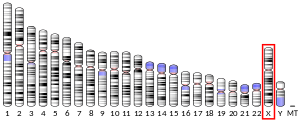ANOS1
Anosmin 1 is a protein that in humans is encoded by the ANOS1 gene. [3]
Function
Mutations in this gene cause the X-linked Kallmann Syndrome. The encoded protein is similar in sequence to proteins known to function in neural cell adhesion and axonal migration. In addition, this cell surface protein is N-glycosylated, and may have antiprotease activity. [provided by RefSeq, Jul 2008].
gollark: Machine learning is somewhat bees in some ways, but it can do really cool stuff which is not currently doable with foolish mortal humans explicitly designing algorithms directly.
gollark: Alternatively, go implement GPT-2-grade text generation or something.
gollark: Okay, go implement a working algorithm to, say, identify if something is "dog" or "cat".
gollark: That isn't much use!
gollark: It can do neat stuff like classify objects!
References
- GRCh38: Ensembl release 89: ENSG00000011201 - Ensembl, May 2017
- "Human PubMed Reference:". National Center for Biotechnology Information, U.S. National Library of Medicine.
- "Entrez Gene: Anosmin 1". Retrieved 2018-08-18.
Further reading
- Söderlund D, Canto P, Méndez JP (June 2002). "Identification of three novel mutations in the KAL1 gene in patients with Kallmann syndrome". The Journal of Clinical Endocrinology & Metabolism. 87 (6): 2589–92. doi:10.1210/jcem.87.6.8611. PMID 12050219.
- Dodé C, Levilliers J, Dupont JM, De Paepe A, Le Dû N, Soussi-Yanicostas N, Coimbra RS, Delmaghani S, Compain-Nouaille S, Baverel F, Pêcheux C, Le Tessier D, Cruaud C, Delpech M, Speleman F, Vermeulen S, Amalfitano A, Bachelot Y, Bouchard P, Cabrol S, Carel JC, Delemarre-van de Waal H, Goulet-Salmon B, Kottler ML, Richard O, Sanchez-Franco F, Saura R, Young J, Petit C, Hardelin JP (April 2003). "Loss-of-function mutations in FGFR1 cause autosomal dominant Kallmann syndrome". Nature Genetics. 33 (4): 463–465. doi:10.1038/ng1122. PMID 12627230.
- Sato N, Katsumata N, Kagami M, Hasegawa T, Hori N, Kawakita S, Minowada S, Shimotsuka A, Shishiba Y, Yokozawa M, Yasuda T, Nagasaki K, Hasegawa D, Hasegawa Y, Tachibana K, Naiki Y, Horikawa R, Tanaka T, Ogata T (March 2004). "Clinical assessment and mutation analysis of Kallmann syndrome 1 (KAL1) and fibroblast growth factor receptor 1 (FGFR1, or KAL2) in five families and 18 sporadic patients". The Journal of Clinical Endocrinology & Metabolism. 89 (3): 1079–88. doi:10.1210/jc.2003-030476. PMID 15001591.
- Lee SH, Han JH, Cho SW, Lee WH, Cha KY, Lee MH (February 2004). "Mutation analysis of the KAL gene in female patients with gonadotropin-releasing hormone deficiency". Yonsei Medical Journal. 45 (1): 107–12. doi:10.3349/ymj.2004.45.1.107. PMID 15004876.
- Hu Y, González-Martínez D, Kim SH, Bouloux PM (December 2004). "Cross-talk of anosmin-1, the protein implicated in X-linked Kallmann's syndrome, with heparan sulphate and urokinase-type plasminogen activator". Biochemical Journal. 384 (Pt 3): 495–505. doi:10.1042/BJ20041078. PMC 1134135. PMID 15324302.
- Cariboni A, Pimpinelli F, Colamarino S, Zaninetti R, Piccolella M, Rumio C, Piva F, Rugarli EI, Maggi R (November 2004). "The product of X-linked Kallmann's syndrome gene (KAL1) affects the migratory activity of gonadotropin-releasing hormone (GnRH)-producing neurons". Human Molecular Genetics. 13 (22): 2781–91. doi:10.1093/hmg/ddh309. PMID 15471890.
- González-Martínez D, Kim SH, Hu Y, Guimond S, Schofield J, Winyard P, Vannelli GB, Turnbull J, Bouloux PM (November 2004). "Anosmin-1 modulates fibroblast growth factor receptor 1 signaling in human gonadotropin-releasing hormone olfactory neuroblasts through a heparan sulfate-dependent mechanism" (PDF). Journal of Neuroscience. 24 (46): 10384–92. doi:10.1523/JNEUROSCI.3400-04.2004. PMID 15548653.
- Söderlund D, Vilchis F, Méndez JP (September 2004). "Polymorphic changes in the KAL1 gene: not all of them should be classified as polymorphisms". Journal of Endocrinological Investigation. 27 (8): 765–9. doi:10.1007/BF03347520. PMID 15636431.
- Hu Y, Sun Z, Eaton JT, Bouloux PM, Perkins SJ (July 2005). "Extended and flexible domain solution structure of the extracellular matrix protein anosmin-1 by X-ray scattering, analytical ultracentrifugation and constrained modelling". Journal of Molecular Biology. 350 (3): 553–70. doi:10.1016/j.jmb.2005.04.031. PMID 15949815.
This article incorporates text from the United States National Library of Medicine, which is in the public domain.
This article is issued from Wikipedia. The text is licensed under Creative Commons - Attribution - Sharealike. Additional terms may apply for the media files.

